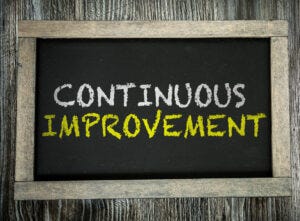February 7, 2023

The industrial concept “continuous improvement” is helping cell therapy developers and their CDMOs make production processes more efficient.
Continuous improvement emerged in the mid-1980s from the Japanese idea of Kaizen – “good change” – which is the practice of reassessing and tweaking processes on a continual basis in real time.
The approach has been used in various industries to optimize complex processes with maintenance monitoring in the automotive industry being one of the most widely cited examples.

Image: DepositPhotos/
gustavofrazao
Cell therapy firms are also starting to use the idea, according to Lyell Immunopharma manufacturing director Christie Marchesseault, who told delegates at the Cell and Gene Therapy Manufacturing and Commercialization Conference, part of Biotech Week Boston last year, that involving all staff is key.
“We’ve implemented a daily meeting structure, sometimes referred to as SQDEP. It stands for safety, quality delivery, economics, and people,” she said at the event in September. “We’ve identified critical KPIs [key performance indicators] in our processes that we track or report on a daily basis, where the team members can come and escalate issues real time as they arise.”
Furthermore, “we’re leveraging a data lake where we’re able to extract all of our data, and we’ve implemented what’s called an Obeya room. It’s a Lean Six Sigma concept where essentially we’re creating a mission control center with full automated capacity to look at our operations and all the data as it’s performing in in the manufacturing facility.”
Closed production platforms
Underpinning Lyell’s continuous improvement strategy are electronic records and “closed” production processes that help reduce the risk of variability, Marchesseault said.
“The use of electronic systems and electronic batch records really allows us to error proof our processes and reduce documentation errors. This also allows for review by exception from our QA team, which really reduces the labor and turnaround times with overall production and review of our records.
“Secondly, we are trying to strive for closed platform processes in our manufacturing… to eliminate risk. Also, by creating platform processes, it reduces variability. Variability inevitably, really impacts your ability to build capacity, which is highly complex with cell therapies. So by creating platform processes, we’re able to reduce that variability, which is going to help us increase capacity.”
Continuous manufacturing
Contract manufacturer AGC Biologics also uses continues improvement to ensure it can cater for the differing needs of its cell therapy clients.
Margherita Neri, vector process development manager at AGC Biologics, told attendees: “The continuous improvement is to keep our manufacturing platform updated to time to see always what is new in the equipment in the solution that are offered by different manufacturers in order not only to be competitive, but also to be cost effective and to try to make cell and gene therapy affordable.”
Again, the focus is on people according to Neri, who said “our technicians are trained to use all the different machines that are on the market in order to be ready when our clients transfer was processes to our facility.”
‘Celling’ point
The benefits of the approach for cell therapy focused CDMOs should not be underestimated according to fellow panelist Gwen Hall, principal and customer executive for life sciences at consulting firm Point B, who cited the Obeya room concept as an example.
“Think about it as a dashboard that is on screen with just in time data that’s coming in and updating this dashboard…So it really helps to facilitate that continuous improvement mind-set.
“If you could imagine having something like that it that you could show to a client that you are wanting to bring into your facility, I think that would say a lot about the health of your organization.”
About the Author
You May Also Like




